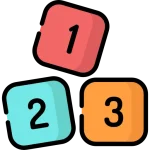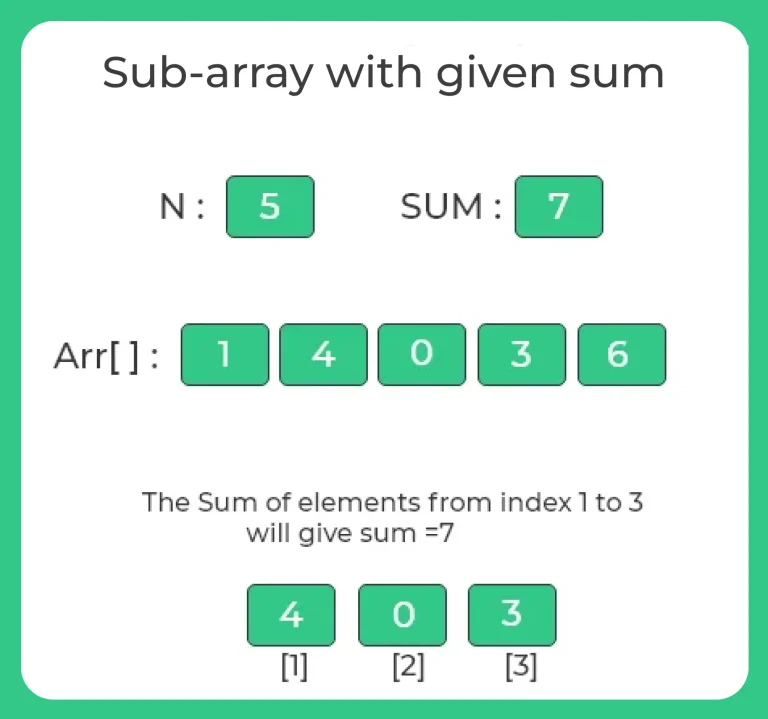Sub-array with given sum in C++
Sub-array with given sum
Here, in this page we will write the program for sub-array with given sum in C++ . Given an Array of non negative Integers and a number. You need to print all the starting and ending indices of Sub-arrays having their sum equal to the given integer . We will understand this problem in detail with algorithm and code in C++

Sub-Array With Given Sum in C++
A Sub-array with given sum code in C++ is a program that to a contiguous subsequence of elements within an array that has a sum equal to a specific target value. In other words, it is a consecutive sequence of elements in an array whose sum is equal to a given sum value. The goal is to find such a sub-array within the given array.
Example : arr[ ] = {1, 4, 0, 0, 3, 10, 5}, sum = 7
Output : Sum found between indexes 1 and 4 Sum of elements between indices 1 and 4 is (4 + 0 + 0 + 3) = 7
On this page we will discuss two different methods for this-
- Naive Approach
- Sliding Window Approach

- Naive approach: The naive approach to find a sub-array with a given sum in C++ involves using a nested loop to check all possible sub-arrays of the given array. For each starting index ‘i’, it checks all sub-arrays starting from ‘i’ and ending at ‘j’, and calculates their sum. If the sum matches the given sum, it prints the indices of the sub-array and returns. If no -with the sum is found, it prints a message indicating the absence of such a sub-array.
Algorithm:
- Take the input array
arrand target sumsumas input. - Initialize
curr_sumto 0. - Traverse the array
arrfrom the first element to the last element with a loop variableiranging from 0 to n-1, where n is the length of the array. - For each
i:- Initialize
curr_sumasarr[i]. - Traverse the array
arrfrom i+1 to n with a loop variablejranging from i+1 to n-1. - For each
j:- Add
arr[j]tocurr_sum. - If
curr_sumis equal to the targetsum, print the starting and ending indices of the sub-array as “Subarray found between indexes i and j” and return. - If
curr_sumis greater than the targetsumorjis equal to n-1, break out of the loop and continue with the next elementi.
- Add
- Initialize
- If no sub-array is found, print “No sub-array found”.
C++ code for Naive Approach
#include <iostream>
#include <vector>
void findSubarray (std::vector < int >&arr, int sum)
{
int n = arr.size ();
for (int i = 0; i < n; i++)
{
int curr_sum = 0;
for (int j = i; j < n; j++)
{
curr_sum += arr[j];
if (curr_sum == sum)
{
std::
cout << "Subarray found between indexes " << i << " and " << j
<< std::endl;
return;
}
}
}
std::cout << "No subarray found" << std::endl;
}
int main ()
{
std::vector < int >arr = { 15, 2, 4, 8, 9, 5, 10, 23 };
int sum = 23;
findSubarray (arr, sum);
return 0;
}
Output
Subarray found between indexes 1 and 4
- Sliding Window approach:The code uses a sliding window approach to search for a sub-array with a given sum. The window, represented by the variables ‘start’ and ‘i’, is moved from the left to the right of the array while maintaining a running sum ‘curr_sum’. If the current sum matches the target sum, the indices of the sub-array are printed. If no sub-array with the sum is found, a message indicating the absence of such a sub-array is printed.
Algorithm:
- Take the input array
arrand target sumsumas input. - Initialize two variables,
startandcurr_sum, to the first element of the array, i.e.,arr[0]. - Traverse the array
arrfrom the second element to the last element with a loop variableiranging from 1 to n-1, where n is the length of the array. - For each
i:- Check if
curr_sumis greater than the targetsum. - If so, increment
startby 1 and subtractarr[start-1]fromcurr_sumuntilcurr_sumis less than or equal to the targetsum. - If
curr_sumis equal to the targetsum, print the starting and ending indices of the subarray as “Subarray found between indexes start and i” and return. - If
curr_sumis less than the targetsumandiis less than n, addarr[i]tocurr_sumand continue with the next elementi.
- Check if
- If no subarray is found, print “No subarray found”.
C++ Code for sliding window approach
#include <iostream>
using namespace std;
void findSubarray (int arr[], int n, int sum)
{
int curr_sum = arr[0];
int start = 0;
for (int i = 1; i <= n; i++)
{
while (curr_sum > sum && start < i - 1)
{
curr_sum = curr_sum - arr[start];
start++;
}
if (curr_sum == sum)
{
cout << "Subarray found between indexes " << start << " and " << i - 1;
cout << endl;
return;
}
if (i < n)
curr_sum = curr_sum + arr[i];
}
cout << "No subarray found" << endl;
}
int main ()
{
int arr[] = { 15, 2, 4, 8, 9, 5, 10, 23 };
int n = sizeof (arr) / sizeof (arr[0]);
int sum = 23;
findSubarray (arr, n, sum);
return 0;
}
Output
Subarray found between indexes 1 and 4
Prime Course Trailer
Related Banners
Get PrepInsta Prime & get Access to all 200+ courses offered by PrepInsta in One Subscription
Get over 200+ course One Subscription
Courses like AI/ML, Cloud Computing, Ethical Hacking, C, C++, Java, Python, DSA (All Languages), Competitive Coding (All Languages), TCS, Infosys, Wipro, Amazon, DBMS, SQL and others
Arrays
- Introduction to Arrays – C | C++ | Java
- Introduction to 2-D Arrays – C | C++ | Java
- Sorting of Array – C | C++ | Java
- Array Rotation – C | C++ | Java
- Reverse an array or string- C | C++ | Java
- Find pairs in array with given sum – C | C++ | Java
- Sort the array in Waveform – C | C++ | Java
- Majority Element in Array – C | C++ | Java
- Boyer-Moore’s Voting Algorithm – C | C++ | Java
- K-pairs with smallest sum in 2 arrays – C | C++ | Java
- Largest Sum Contigous SubArray – C | C++ | Java
- Maximum Average Sub-array of K length – C | C++ | Java
- Size of sub-array with max sum – C | C++ | Java
- Sub-array with given sum – C | C++ | Java
- Triplet that sum to a given value – C | C++ | Java
- Segregate 0’s and 1’s in array – C | C++ | Java
- Segregate 0’s 1’s and 2’s in array – C | C++ | Java
- Sort elements in array by frequency – C | C++ | Java
- Finding pythagorean triplets in an array – C | C++ | Java
- Reorder array using given indexes – C | C++ | Java
- Merging two sorted arrays – C | C++ | Java
- Minimum number of Merge Operations to make an Array Palindrome – C | C++ | Java
- Find Zeros to be Flipped so that number of Consecutive 1’s is maximized – C | C++ | Java






Login/Signup to comment